Labrador Retrievers are known for their friendly, affectionate nature, but they also have big appetites!
As a responsible pet owner, it’s important to understand: how much should a lab eat, when to switch from puppy food to dog food Labrador, and what to feed your Lab to keep them at a healthy weight and maintain their overall well-being.
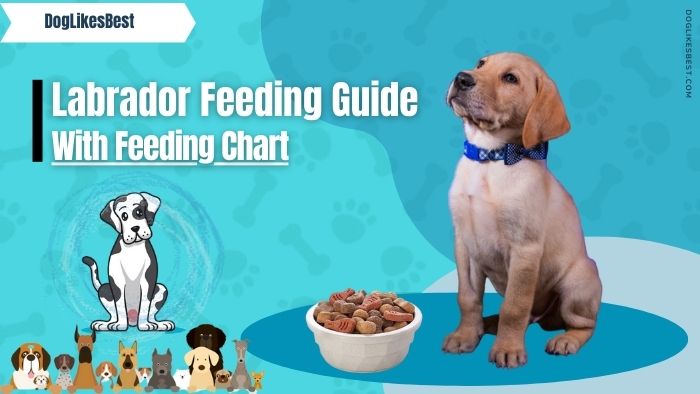
For your convenience, we have prepared a Labrador feeding chart by age and jotted down the major factors to look at before feeding your furry pal.
Keep reading to get all the information, you need to make informed decisions about your Labrador’s diet.
Contents
How Much to Feed Labrador Puppy-Feeding Chart
Like other breeds, in the first few weeks, Labrador puppies rely on their mother’s milk, which helps to boost their immune system. After 4th week, you can start offering him high-quality puppy-formulated food. It is recommended to feed them at least thrice or four times a day. Their body is at a growing stage, it needs more healthy food for better development.
As per AKC, “Growing pups should be fed puppy food, a diet specially formulated to meet the nutritional needs for normal development. Feeding adult food will rob your puppy of important nutrients.“
Furthermore, it’s important to feed your Labrador puppy the correct amount of food, so that you don’t overfeed them. We have prepared a Labrador puppy feeding chart, which will give you the proper food and calorie ratio.
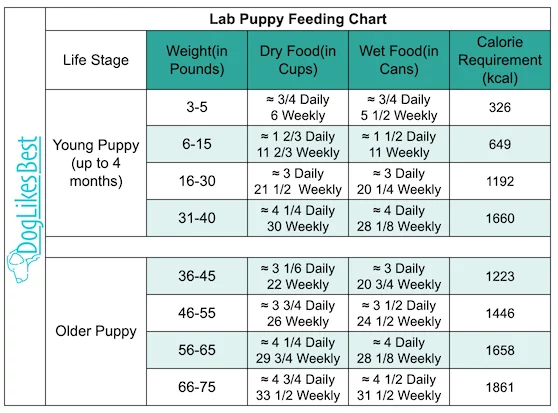
For instance, if you are raising a young Labrador puppy, it’s suggested to first check the weight and then select the feeding ratio. If he weighs around 6-15 pounds, then 1 2/3 cups daily is more than enough, with 649 kcal per day.
Note:- Divide per day feeding ratio into four equal intervals and then feed your pup. This will help you to keep a track of the calorie ratio, and you will not overfeed your Labrador puppy.
Adult Labrador Feeding Ratio
Your Labrador nutrient requirements change with age, when they reach adulthood you need to switch their food. It is suggested to start feeding your Lab, adult dog food when he turns one year old.
Along with switching food, you need to change their feeding ratio because as their activity level increases, the demand for food also increases. For your better preference, we have prepared an adult Labrador feeding chart, which will help you to feed him the correct amount of food.
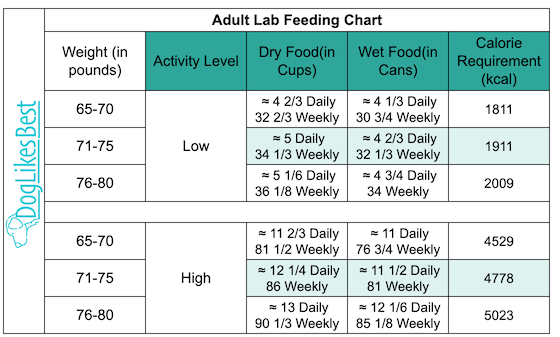
An Adult Labrador with high activity will need more food than one with less activity. For instance, your adult Lab, whose weight is around 65-70 pounds, requires 11 2/3 cups daily with 4529 kcal per day. On the other hand, if he is not an active one then you need to feed him 1811 kcal per day.
Note:- Always seek advice from the vet before switching your pup’s food. It is suggested to go for high-quality food that is specially formulated for larger breeds.
Senior Labrador Feeding Ratio
When your Labrador turns 7 years old, he enters the senior hood zone. His body structure, eating habits, and activity level all vary with time. You cannot feed him adult dog food, now you have to switch to senior dog food. This is because now his body will require more protein to maintain their joints and muscle health.
For your reference, we have prepared a PDF of a senior Labrador feeding chart, which is bifurcated into weight and activity level.
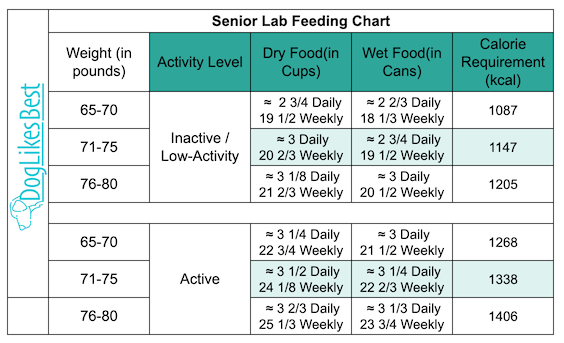
For instance, your oldie Lab whose weight is around 71-75 pounds, and is moderately active by nature, In such a scenario, it is suggested to feed 3 1/2 cups daily with a total calorie intake ratio of 1338 kcal per day.
On the other hand, if your oldie Lab is not an active one, then it is advisable to cut down the calorie ratio. Without any physical activities, his body won’t be able to digest food easily, and this will lead to health issues in the future.
Labrador Feeding Tips
So far you read about the Labrador feeding chart, and how the feeding ratio varies as per their life stage, weight, and activity level. Now, let’s have a look at the feeding tips, which will help you to select the appropriate dog food for your furry pal.
Before following the feeding guide, it’s important to have knowledge regarding the nutrients, weight, activity, level, and foods to avoid.
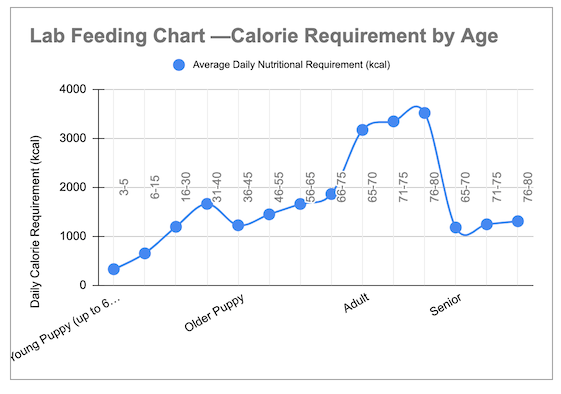
So, you can select the appropriate dog food for your Lab, as per his health. And feed him the correct amount of food.
Let’s quickly explore the important factors:
1. Nutrients Guidelines
One should know how to check the nutrient list while purchasing dog food for their pup. This is because providing high-quality dog food to your Labrador is very important, selecting an appropriate food solves half of your problem.
PetMD states, “Nutritional dilated cardiomyopathy (nutritional DCM) is a heart disease Labrador Retrievers may acquire by eating a grain-free diet that contains peas, legumes, or lentils among the top five ingredients. DCM causes the heart to become dilated and unable to function properly.“
It has been noticed that few Labradors are allergic to grains, so it’s recommended to feed grain-free food. But still, you need to check out the ingredients list. There are a few food products, which include peas, lentils, and other ingredients, which are not good for his health and lead to severe health issues in the future.
Here is the essential nutrient list which should be there in your Lab’s food in an appropriate ratio.
- Meat Protein
- Omega-3
- Omega-6
- Carbohydrates in moderate amount
- Grain-free
- Glucosamine and Chondroitin
- Vitamins and Minerals
Note:- Make sure you are feeding high-quality food enriched with all these essential nutrients. Follow the Labrador feeding chart, it will help you to feed your pup the correct amount of food and calories.
2. Weight Consideration
The ideal weight of an adult male Labrador is around 65-80 pounds, and an adult female Labrador is 60-80 pounds. It’s important to maintain your Lab weight because they are prone to obesity. If you do not keep an eye on their feeding habits, then there are chances they will gain unwanted fats.
Furthermore, it has also been noticed that they are one of the greediest breeds, they have the habit of demanding treats. It is advisable not to feed them frequently, it will create health issues.
We recommended you check your Labrador’s weight and accordingly select the feeding ratio from our given chart. For example, if you are raising an adult Labrador, who weighs around 65-70 pounds, it is recommended to feed him 4529 kcal per day.
Note:- Your Lab’s feeding ratio solely depends on his age, weight, and activity level. So, you have to keep a track of his weight and calorie intake ratio. This will help you to give your furry pal a healthy and happy lifestyle for a longer period of time.
3. Activity Level
Well, focusing on the activity level is one of the major factors to look upon while feeding your Labrador, it helps you to select the appropriate food ratio as per their body requirement.
Let me explain it to you with an example, suppose you are raising an adult Lab, whose weight is around 71-75 pounds. Your furry pal is a super active one, loves to go for a walk, carries out all the physical activities, etc. In such a scenario, it is recommended to feed, him, 4778 kcal per day.
The more active your Lab is, the more he will require calories to meet his body’s needs for better development. Plus, adult Labradors’ metabolism works effectively, they can digest food easily if fed in the correct ratio.
Note:- It is suggested to take your Labrador for a walk at least twice a day, and regular exercise is a must for them. This will not only keep him active, but also his metabolism will work effectively, and could easily digest the food.
4. Foods to Avoid
It’s very natural to share your meal with the furry pal, but you have to be careful because you cannot feed everything to your dog. Their body cannot take all types of ingredients.
Here’s a list of ingredients, which you should avoid feeding your Labrador.
- Nuts
- Chocolate
- Onion and Garlic
- Alcohol
- Milk
- Ice cream
- Cheese
- Caffeine
- Yeasty Dough
Make a habit of checking the ingredient list, and avoid toxic ingredients which can harm your furry pal’s health. Once you are cleared with the ingredients, select the appropriate one for your Lab and feed him.
You can refer to our Labrador feeding chart. It will give you an idea regarding the food and calorie ratio so that you won’t jumble up and end up overfeeding your furry pal.
Note:- Consult the vet before selecting commercial dog food for your Lab because they will guide you on which ingredients are more suitable to your furry pal’s body, and can easily be digestible.
FAQs
How much food should I feed my Labrador?
Generally, it is recommended to feed 11 1/2 cups daily to your healthy adult Labrador, but this feeding ratio varies. It solely depends on your Lab’s life stage, weight, and activity level. For instance, if you are raising an adult Lab but is not an active one, then it is suggested not to feed him more calories. As his body won’t be able to easily digest it, which will lead to weight gain and other health issues in the future.
Why labs are always hungry?
It has been noticed, Labrador is the greediest one, they keep demanding tempting treats. It’s not like they are always hungry, out of their eating habits they want more and more food. Even after feeding him an ample amount of meals, if he is demanding treats, then don’t give him. This is because it will lead to overfeeding will gain weight and health complications.
Is rice good for Labrador?
Yes, rice is good for Labrador. Many dog food brands include brown rice in their meal. If you feed rice to your Labrador, it’s good, it will make his immune system and metabolism stronger and will work effectively. However, always feed him in limits because overfeeding is not good for his health.
Is boiled egg good for Lab?
Eggs are good for dogs, it contains protein, vitamin, and fatty acid, which is good for their health. You can feed boiled eggs to your Labrador, it will boost his immune system, and make metabolism more effective. In fact, eggs are good for large breeds.
Well, It’s a Wrap!
Now, we know feeding a Labrador involves choosing high-quality food, and feeding them the correct amount of food. Furthermore, keep a track of their weight, and activity level, and accordingly feed them. This will prevent you from overfeeding him.
Labradors are the greediest breed, even if their stomach is full, they will demand more treats. So, you have to be very careful, while feeding him, and make sure your pup carries out daily exercises.
By following these guidelines, you can help your Lab maintain a healthy weight and enjoy a long and happy life.
Feel free to download our Labrador feeding chart, for your future reference.
REFERENCE:
- Heinze, C. V. R. (2022, August 17). All About Ash. Clinical Nutrition Service at Cummings School. Retrieved March 3, 2023, from https://vetnutrition.tufts.edu/2022/08/all-about-ash/
2. John, J. D. (2023, March 3). What is Ash in Dog Food? And Its Importance. DogLikesBest. Retrieved March 3, 2023, from https://www.doglikesbest.com/what-is-ash-in-dog-food
3. John, J., DVM. (2023, March 7). How Much Should a Lab Eat | Labrador Feeding Chart by Age | DogLikesBest. DogLikesBest. Retrieved March 7, 2023, from https://www.doglikesbest.com/labrador-feeding-chart/

Julia is a Board Certified Veterinary Nutritionist, practicing veterinarian in a non-profit animal hospital and feline sanctuary located in Rochester, NY. She is also a full-time veterinary advisor at DogLikesBest. She focuses on writing healthcare-related topics including dog foods, treats, veterinary diets, food for specific healthcare features, etc. Moreover, any article on DogNeedsBest that has to concern feline health in any way, goes under her scrutiny before being published.


